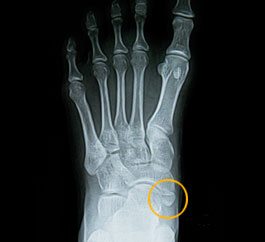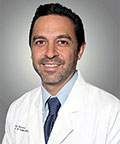- Home
- Foot & Ankle Conditions
- Pediatric Conditions
- Accessory Navicular
Accessory Navicular: causes, symptoms and treatment
- Published 6/1/2018
- Last Reviewed 12/2/2024

What is an accessory navicular?
The accessory navicular (os tibiale externum) is an extra piece of cartilage or bone located midfoot just above the arch on the inside of the foot.
This ossicle (extra bone) is usually encased in the posterior tibial tendon, which attaches the foot's inside (medial) arch to the calf muscle. Accessory navicular is commonly seen in pediatric patients.
Most people do not have an accessory navicular. People who do have one are born with this condition and may go their whole lives without realizing it. Others will experience pain and foot deformities.
- Why does an accessory navicular require bone treatment?
- What are the symptoms of accessory navicular syndrome?
- How is accessory navicular syndrome diagnosed?
- What are accessory navicular treatment options?
- What is accessory navicular bone surgery?
- University Foot & Ankle Institute is ideal for accessory navicular treatment
-
ABFAS® Board Certified in Foot Surgery and Reconstructive Rearfoot and Ankle Surgery. and Director of University Foot and Ankle Institute
Dr. Bob Baravarian DPM, FACFAS is a Board-Certified Podiatric Foot and Ankle Specialist. He is an assistant clinical professor at the UCLA School of Medicine and serves as Director of University Foot and Ankle Institute.
Dr. Baravarian has been involved in athletics his entire life and played competitive tennis in high school and college. He has an interest in sports medicine, arthritis therapy, and trauma/reconstructive surgery of the foot and ankle. He is also fluent in five languages (English, French, Spanish, Farsi, and Hebrew),
-
ABFAS® Board Certified in Foot Surgery and Reconstructive Rearfoot and Ankle Surgery. and Director of University Foot and Ankle Institute
Dr. Bob Baravarian DPM, FACFAS is a Board-Certified Podiatric Foot and Ankle Specialist. He is an assistant clinical professor at the UCLA School of Medicine and serves as Director of University Foot and Ankle Institute.
Dr. Baravarian has been involved in athletics his entire life and played competitive tennis in high school and college. He has an interest in sports medicine, arthritis therapy, and trauma/reconstructive surgery of the foot and ankle. He is also fluent in five languages (English, French, Spanish, Farsi, and Hebrew),
 Dr. Nalbandian and her team are the simply the best. I had other options, but I traveled more than 100 miles to get the surgery...Myung S.
Dr. Nalbandian and her team are the simply the best. I had other options, but I traveled more than 100 miles to get the surgery...Myung S. Please provide handicap parkingBarry S.
Please provide handicap parkingBarry S. Dr. Ambibola Johnson is awesome!Laurie S.
Dr. Ambibola Johnson is awesome!Laurie S. I appreciate the care and timeliness of all my appointments I’ve had at UFAI. Gray, Lydia and the staff all are wonderful. Lydi...Edelmira G.
I appreciate the care and timeliness of all my appointments I’ve had at UFAI. Gray, Lydia and the staff all are wonderful. Lydi...Edelmira G. Very greatfull for the doctor and stuffJesus M.
Very greatfull for the doctor and stuffJesus M. Saw Dr. Franson in Valencia.
Saw Dr. Franson in Valencia.
He’s trying to help me with my ankle. Orthotics are helping.David W. Doctor was very caringBrigitte S.
Doctor was very caringBrigitte S. Everyone is very nice and efficient-
Everyone is very nice and efficient-
Especially Dr Kelman. He takes very good care of me!!Claudia K. Great costumer service.
Great costumer service.
Prompt and efficientDean W. No . I’m pleased with the care .Michael P.
No . I’m pleased with the care .Michael P. Appreciate the professionalism and expertise, as well as the caring.Stella G.
Appreciate the professionalism and expertise, as well as the caring.Stella G. I had a very positive experience with Dr Franson and the staff at University Foot & Ankle. I've been going for treatment and ch...Karolina N.
I had a very positive experience with Dr Franson and the staff at University Foot & Ankle. I've been going for treatment and ch...Karolina N.
